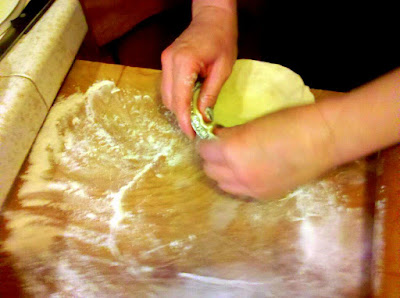I don't know what made me crave a chicken pot pie, but I had the fever this week: making one on Tuesday and one last night for a friend and her son. So this week will be the first that I have a guest on Cooks with Skipper, as she helped me assemble and whipped up some mashed spuds. Since the server at my office has been down since Wednesday, I've had plenty of time to walk between my computer checking to see if it's back up and the kitchen to tend to broth.

I know, it's a dutch oven and not a stock pot, but my stock pot is still with a friend that I've been neglecting to pick up. Basically, I threw the following into le Creuset to saute golden brown in half a stick of butter:
1 onion
2 carrots
3 stalks celery
5 clv garlic
2 parsnips
1 large turnip
1/2 celery root
To this, I added 1.5 qts of water, half a bunch of parsley, and a bag of collected chicken bones from the freezer. Then I brought it to a boil and simmered for 1 1/2 hrs.
Meanwhile, I roasted three chicken thighs in the oven and took one of the most disgusting photos evar.
I've taken it this far, so I went ahead and made pie crust.
In the food processor, I pulsed 1 c flour with 1/2 tsp salt, added 4 tbs cold cubed butter and mixed until grainy, 1 shot vodka and enough water until the dough holds together when pressed with your fingers. This gets wrapped and chilled for at least an hour to let the flour proteins to do their thing.
I left my camera battery on the charger so I used a camera phone for the following photos.
After all this, you take everything to your friend's house and have her roll out the pie crust...
and lay them in pot pie tins that she will happen to have.
While your friend does this, you saute more of the same root vegetables in butter...
 add the cubed chicken and frozen peas (yea, I know. I didn't go and fetch fresh ones); cover with flour, stir in, and allow to cook until the flour browns on the surface of the vegetables; add broth to cover, bring to a boil, and reduce the heat to simmer for five minutes. I realize that cream is normally added but since pot pies are heavy enough with butter, it really doesn't need it and working off my gut is hard enough.
add the cubed chicken and frozen peas (yea, I know. I didn't go and fetch fresh ones); cover with flour, stir in, and allow to cook until the flour browns on the surface of the vegetables; add broth to cover, bring to a boil, and reduce the heat to simmer for five minutes. I realize that cream is normally added but since pot pies are heavy enough with butter, it really doesn't need it and working off my gut is hard enough.Cover with the top crust and puncture holes with the initial of the person for whom the pie is intended.
Brush with an egg wash and bake at 375°F until the top is golden brown.
Break open and do what you want with it.



















